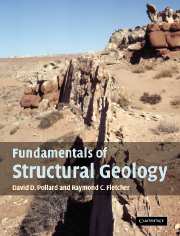Chapter 5 - Deformation and flow
Summary
Nearly undeformed (upper left) and deformed (lower right) oöids with spherulitic cores viewed in thin section. Matrix is calcite with some mud and average ratios of long to short axes are 1.16 and 1.56 respectively. Samples from near Harrisonburg, VA. Reprinted from Cloos (1971, Plates 9 and 11) with permission of The John Hopkins University Press.
A clear separation between geometrical and dynamic considerations was maintained by Becker, the American geologist, at a very early date, and he referred to the English physicist Thomson (Lord Kelvin), who says very clearly: ‘We can see, therefore, that there are many attributes of movement, displacement, and deformation which can be considered independently of force, mass, chemical composition, elasticity, heat, magnetism and electricity; and it is of greatest use to science for such properties to be considered as a first step’ (Sander, 1970, p. 12).
Most structural geologists think about deformation and flow in an inverse problem mode: from the final state back toward the initial state of the deformed body of rock. For example, the lower right photograph in the frontispiece for this chapter shows deformed oöids with elliptical shapes: ratios of long to short axes are about 1.56 (Cloos, 1947, 1971). The upper left photograph shows nearly undeformed oöids with approximately circular shapes: ratios of long to short axes are about 1.16.
- Type
- Chapter
- Information
- Fundamentals of Structural Geology , pp. 152 - 193Publisher: Cambridge University PressPrint publication year: 2005



